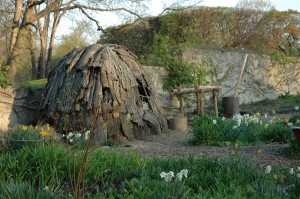Plan Your Weekend: Lenape Wigwam Brings Peace—and Giggles
Posted in Exhibitions, Programs and Events, The Edible Garden on September 4 2009, by Plant Talk
 |
Annie Novak is coordinator of the Children’s Gardening Program in the Ruth Rea Howell Family Garden. Click here to see a Today show segment about the program. |
 A few weeks ago, during one of many rainstorms in the Ruth Rea Howell Family Garden this summer, I took refuge with a few students from our Children’s Gardening Program in the wigwam tucked in the side corner of the garden’s Meadow. While the kids played giddy musical chairs on the stumps inside, I sat quietly with my back against the bark wall. It’s a cozy space. Although the kids were acting loud and giggly, the small wigwam felt peaceful. The rain fell near-noiselessly on the dome of birch saplings. Through the wigwam’s single window, daylilies and tall zebra grass shone orange and green against the gray.
A few weeks ago, during one of many rainstorms in the Ruth Rea Howell Family Garden this summer, I took refuge with a few students from our Children’s Gardening Program in the wigwam tucked in the side corner of the garden’s Meadow. While the kids played giddy musical chairs on the stumps inside, I sat quietly with my back against the bark wall. It’s a cozy space. Although the kids were acting loud and giggly, the small wigwam felt peaceful. The rain fell near-noiselessly on the dome of birch saplings. Through the wigwam’s single window, daylilies and tall zebra grass shone orange and green against the gray.
Part of the Three Sisters display garden, the wigwam was built in 2006 to re-create the lifestyle of the Lenni-Lenape, the first New York natives. When teaching, I often ask my students to imagine what it would be like to live as the Lenape did 400 years ago. I ask the children to think about everything they do inside their homes—cook, read, watch TV, play with toys, take refuge in air conditioning when the summer hits—and think of what the Lenape would be doing instead. With seven-year-olds, of course, a reflective discussion like this leads to hilarity pretty quickly.
But after some groans and giggles about sharing a bedroom with your whole family, comparing lifestyles leads to an epiphany as well. The wigwam only seems small in comparison to today’s houses when you think about it as an equal living environment. But it isn’t. In those early, pre-hustle-and-bustle New York years, an entire world around the home provided the space for cooking, playing, harvesting. (Who needs air conditioning with the Bronx River running so close by?) What I like about the wigwam is its clear definition of necessity. It’s a space of shelter and sleep. Imagination provides the rest.
